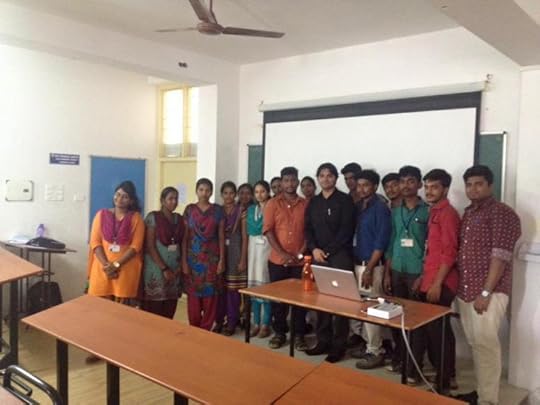Santosh's Blog, page 54
June 24, 2016
The Art of Cracking Interviews: Drill exercises
Career isn’t about making money as everyone makes something. Rather it’s a way of living that would create memorable memories to look back and smile
Click to view slideshow.


June 15, 2016
Mock: Resume & Interviews
June 9, 2016
Interview Skills: Participative Learning
June 8, 2016
Writer’s Thought
June 6, 2016
Life with Dreams
June 5, 2016
Is one member of your group bossy?
Welcome to the next article, today let’s try to explore ‘why sometimes decisions taken by a group seem ineffective?’ I’m sure we all had an experience going out with a bunch of friends to watch a movie with two or several options to choose. Even though one or two might not actually agree to the decision, may be cause didn’t want to sound ‘un-supportive’. Sounds familiar?! People tend to agree possibly of person who takes up leadership position is dominated or bossy, making it difficult to disagree otherwise. This phenomena is termed as ‘Groupthink’. This phenomena occurs when a group makes ineffective decisions for the sake of reaching a consensus. This become a major hurdle for creativity and independent thinking. Just for the sake of group cohesion one need to give up alternatives and confidence to present unpopular decision. This in turn hinders the problem solving ability of the group. This leads to disregarding the idea and accepts illogical approaches to maintain harmony among the members of group. This ultimately leads to low probability of success.
Let’s try to understand the additives of ‘Groupthink’:
Decision makers constitute a cohesive group.
Structural faults of the group (often insulates from outside, directive style of a leader and other factors)
There exists proactive situation context (High stress to bring result, self-esteem is hit low, and other factors)
When the above additives come together in a ‘short time’, pre-decision seem decision taken and the group that does this decision are part of ‘Groupthink’ because:
Overestimation of the group
Closed mindness
Pressure towards uniformity
Omission in survey of objectives and alternatives
Errors in search of information
How does one overcome the ‘Groupthink’?
A framework with rules and process
Participation of every member
Divide into smaller group
Support debate and conflict
Examine alternatives
Invite outside experts
Leaders to hold and reflects opinions
Have a devil’s advocate
I hope we had some interesting understanding on Groupthink. Let’s look into this in our next article. Next week I shall begin with a new topic on ‘Self’. Till then, Good day!


June 4, 2016
Sarbjit: Strong example of Minority Influence
Welcome to the next article, today let’s try to explore can minority (not the religious) influence the majority in decision making? I shall take a example of Sarbjit movie as a case to discuss the next article.
Largely people like to conform to majority because they want to belong to some group, this is termed as normative influence. This exists at home, work and with strangers in a situation. If the world lies one cannot be true! This scenario is sketched in the initial years of struggle of Dalbir Kaur seeking help of her brother Sarabajit Singh who convicted of terrorism and spying by Pakistan court.
Deviation from normative influence is possible when one believes in what they are saying, this reflects at point when Dalbir Kaur makes a point of seeking justice for her missing and falsely convicted brother. This struggle period of a decade that gains in momentum with several others believing in the beliefs, values and behavior. Why one do get to agree to one person? Others often analyse the message that comes out of conviction. The movie tells us that Dalbir Kaur made several attempt that the person to be convicted is walking free. When the content seem right the belief of others automatically matches to the belief of the individual, this is termed as informative influence. The movie progress to show that more and more people conform to the consistent message, this affect is known as snowball effect. What follows this is minority becoming majority. A critical mass stands to seek a solution. The indicates the normative influence that has majority. Initially others who were unsure of the support and have conformed would forget the why and how this change happened, this phenomena is known as social crypto-amensia.
Movies like Sarabjit are important to showcase/stand to others that each individuals could bring the desired change for making the world a better place to live. Next week I shall begin with a new topic on ‘Self’. Why one is important for themselves?’ Till then, Good day!
~Santosh Avvannavar, Author of She: Ekla Cholo Re~


Sarabajit: Strong example of Minority Influence
Welcome to the next article, today let’s try to explore can minority (not the religious) influence the majority in decision making? I shall take a example of Sarabajit movie as a case to discuss the next article.
Largely people like to conform to majority because they want to belong to some group, this is termed as normative influence. This exists at home, work and with strangers in a situation. If the world lies one cannot be true! This scenario is sketched in the initial years of struggle of Dalbir Kaur seeking help of her brother Sarabajit Singh who convicted of terrorism and spying by Pakistan court.
Deviation from normative influence is possible when one believes in what they are saying, this reflects at point when Dalbir Kaur makes a point of seeking justice for her missing and falsely convicted brother. This struggle period of a decade that gains in momentum with several others believing in the beliefs, values and behavior. Why one do get to agree to one person? Others often analyse the message that comes out of conviction. The movie tells us that Dalbir Kaur made several attempt that the person to be convicted is walking free. When the content seem right the belief of others automatically matches to the belief of the individual, this is termed as informative influence. The movie progress to show that more and more people conform to the consistent message, this affect is known as snowball effect. What follows this is minority becoming majority. A critical mass stands to seek a solution. The indicates the normative influence that has majority. Initially others who were unsure of the support and have conformed would forget the why and how this change happened, this phenomena is known as social crypto-amensia.
Movies like Sarabjit are important to showcase/stand to others that each individuals could bring the desired change for making the world a better place to live. Next week I shall begin with a new topic on ‘Self’. Why one is important for themselves?’ Till then, Good day!
~Santosh Avvannavar, Author of She: Ekla Cholo Re~


June 3, 2016
Do group dynamics intensify our opinions?
“My direction is mine, your direction is yours” – Santosh Avvannavar
Welcome to the next article, today let’s try to explore ‘do group interaction effect good or bad?’ A concept that one would move towards their own position than coming to a consensus is termed as group polarization. This happens because of the attitudes and decisions come out in actuality. Lets take an example of group friends over a table for lunch. Few orders ‘chicken’ and remaining orders ‘egg’, the one with chicken persuade to take a bite. On the other hand people may take a bite but might stick to egg over chicken. This is likely to enhances their opinions of their initial choice! This informs us groups often make cautious or risky shift in their decision.
But why do groups polarize? This can attribute firstly to their social comparison that consists of values & beliefs and secondly risk taking attitudes or cautious more. Individuals usually conforms to their choices and line up with their choice. However this can further influence on the information that was otherwise unavailable to them earlier. This is likely to re-position on the arguments but this attitude change doesn’t come merely happen by hearing or observing but by active participation. How do we avoid group polarisation? There are numerous ways of avoiding it, firstly by bringing wide range of experience to look into the information. Secondly, research materials or handouts could be brought if ones’ opinion differs from several others. Thirdly, A group leader who could play devils advocate, by encouraging others to listen/accept the opposing members views.
Let me give an hypothetical situation. I was handling a course that had several failures after the test, as we know success does catch attention failures do! In the discussion everyone were persuading me to be considerate to pass the students. I might likely shift towards others because of the various factors or go against to break the polarization with information to prove the causes.
In nutshell, individuals need to be aware of any extreme attitude changes and the decisions that follow.
I hope we had some interesting understanding on group polarisation. In the next article we shall try to explore, what would happen to the decision that taken by group that keeps beliefs and values aside? Let’s look into this in our next article. Till then, Good day!


June 2, 2016
Why learned people are unlikely to be politician?
This piece of writing is out of more observations rather backed with research hence views could vary.
Over two decades I have observed that learned people had difficult time to put their foothold to be a politician. Even some who have made it to the top had shaky career in politics. In spite the growth in information excess and dissemination on ‘know your candidate’, before the elections. This information is yet to make a remarkable change in choosing the candidate. I wondered why?!
I see that the way the candidates persuades the voters by the depth of conviction than the height of logic. People who have used the latter are often defeated over the conviction. May be we buckle more to enthusiasm over the proof of credibility.
Seems logically? What do you think?
– Santosh Avvannavar, Author of She: Ekla Cholo Re



















